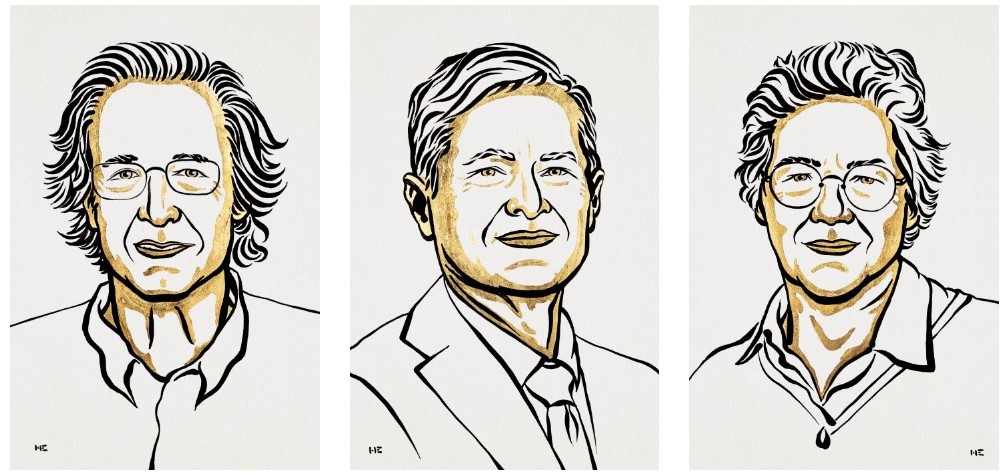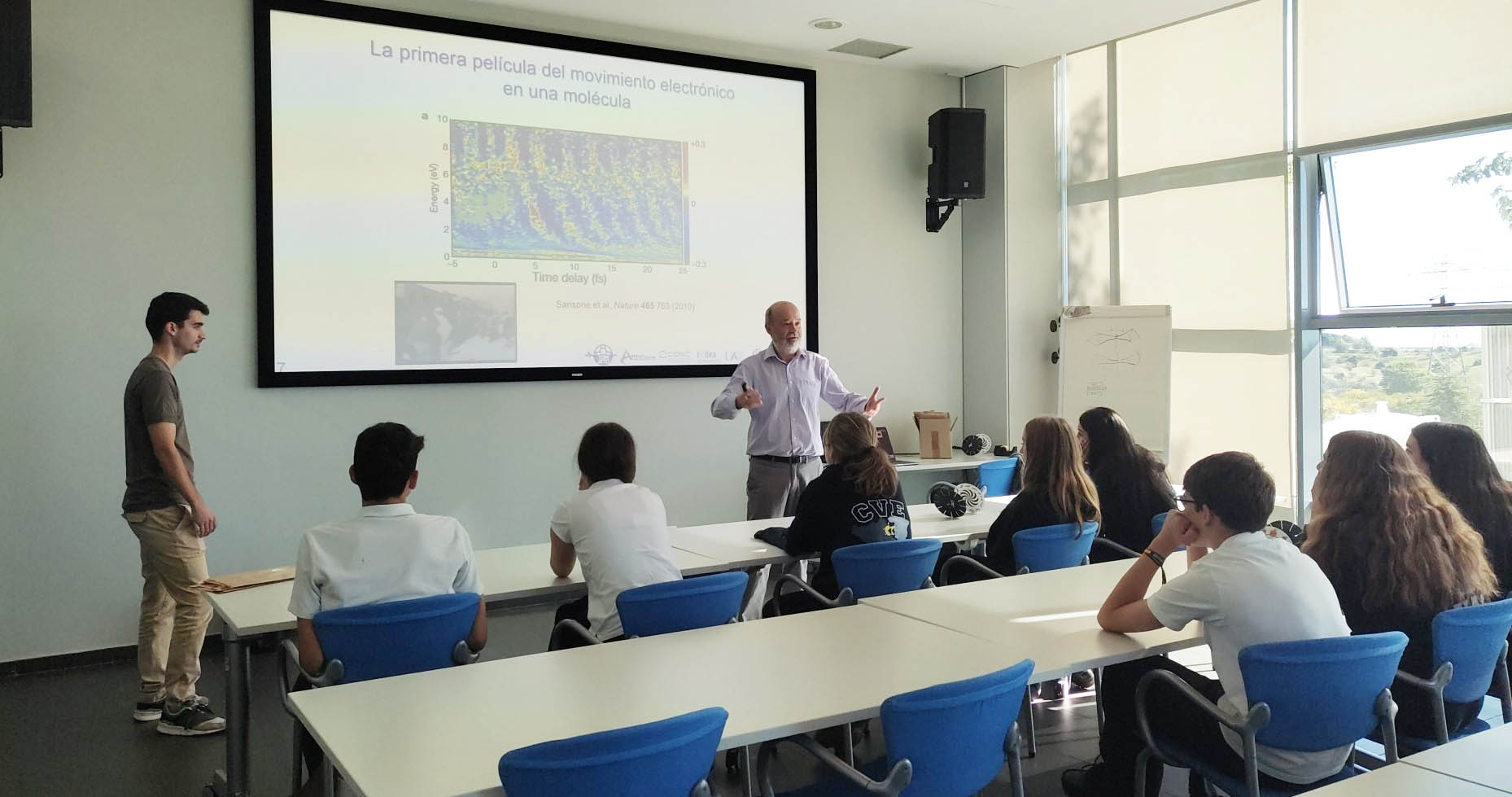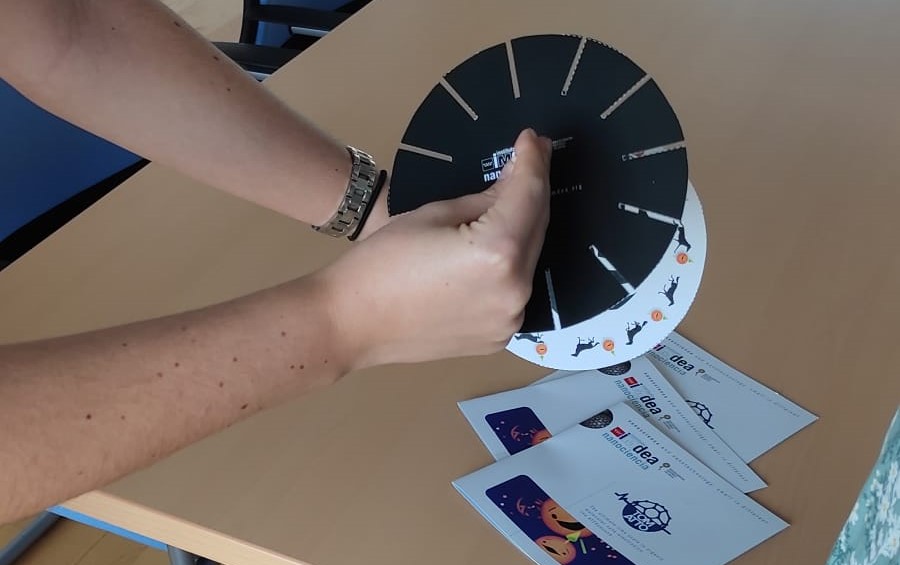Nobel Prize in Phyisics 2023 and the attochemistry at IMDEA Nanociencia
06.10.2023
 |
|
Agostini, Krausz y Huillier. Credit: Niklas Elmehed © Nobel Prize Outreach. |
- The 2023 Nobel Prize in Physics has been awarded to Agostini, Krausz and Huillier for the development of experimental methods that allow generating ultrashort attosecond pulses of light.
- Attosecond light pulses are key to studying the dynamics of electrons in matter.
- IMDEA Nanociencia conducts research in the field of attoscience through the ERC-Synergy TomATTO project.
Madrid, 6th of October, 2023. The Royal Swedish Academy of Sciences has awarded the 2023 Nobel Prize in Physics to Profs. Pierre Agostini (Ohio State Uni.), Ferenc Krausz (MPIQO, Uni. München) and Anne L'Huilier (Lund Uni.) "for experimental methods that generate attosecond pulses of light for the study of electron dynamics in matter." Thanks to their experiments, this year's laureates devised and created pulses of light short enough to take snapshots of the very fast movements of electrons.
In the 90s, Anne L'Huillier and her collaborators discovered a new effect of the interaction of laser light with the atoms of a gas. Once the theoretical foundations were laid, the roadmap towards the generation of attosecond light pulses was outlined. Ferenc Krausz and Pierre Agostini showed that this effect can be used to create shorter light pulses than was previously possible. For this extraordinary work, L'Huillier and Krausz were awarded this year's BBVA Frontiers of Knowledge Award, and were nominated by Prof Fernando Martín, professor in the Department of Chemistry of the Faculty of Sciences (UAM) and scientific director of IMDEA Nanociencia. The path to isolating attosecond pulses required technical developments that Krausz explored in collaboration with Prof. Mauro Nisoli in Milan.
Attophysics techniques not only allow us to capture the movement of electrons, but have also opened the door to the possibility of manipulating these subatomic particles.
Attophysics techniques not only allow us to capture the movement of electrons, but have also opened the door to the possibility of manipulating these subatomic particles. "Once you achieve the ability to visualize this movement in real time," says Prof Martín, "you can probably also use these light sources to manipulate it, and from there modify its behaviour and properties, with applications in multiple areas." The applications are numerous: from its use in biomedicine and electronics to the search for new clean sources of energy.
The attochemistry
In 2017, a group of Spanish and Italian researchers (led by Fernando Martín and Mauro Nisoli) laid the foundations of attochemistry, a new discipline that studies the movement of electrons during chemical reactions using attosecond pulses of light (that is, 10-18 seconds, the shortest time interval ever measured). Among the potential applications of this nascent discipline is the improvement of photovoltaic cells, sources of clean and renewable energy, key in the fight against climate change.
The AttoChem COST Action network, of which L'Huillier is a member, is chaired by Prof. Martín and coordinates theoretical and experimental efforts to exploit the broad potential of attosecond techniques in chemistry, with the aim of designing new strategies that control charge migration (electrons) in molecules acting directly on the attosecond scale.
Research in the Region of Madrid
The FULMATEN Synergic Project, funded by Comunidad de Madrid, was designed to place the Madrid region at the level of the leading countries in terms of capacity to visualize processes at the attosecond scale in condensed phase systems, such as Germany, the United Kingdom and the United States. In addition, the ability of FULMATEN-CM to produce theoretical models and computer codes, with the help of the Spanish Supercomputing Network (RES) and the European Supercomputing Network (PRACE), drove the goal of achieving the necessary understanding of charge transfer in the conversion of light energy into electrical energy and, therefore, the optimization of photovoltaic cells.
The FULMATEN project was the seed of the subsequent TomATTO Synergy project, funded by the European Research Council (ERC). Professor Fernando Martín currently leads the TomATTO consortium, an ambitious scientific project that aims to capture the ultrafast dynamics of electrons with the aim of improving the conversion efficiency of solar energy. By observing, understanding and controlling the excitation of molecules in solar cells, the researchers say, the performance of these devices could be improved, which currently only manage to convert less than 25% of the solar energy that reaches them.
Throughout the project, TomATTO researchers will have to overcome three major challenges: 1) record the first electronic processes initiated by light absorption; 2) design new organic materials to control electronic dynamics; and 3) develop computational methods to understand the results. To this end, the research team of the TomATTO consortium, led by Fernando Martín (IMDEA Nanociencia, Universidad Autónoma de Madrid), Nazario Martín (Universidad Complutense de Madrid) and Mauro Nisoli (Instituto Politécnico de Milán), join forces in this synergistic project. The TomATTO project, coordinated from IMDEA Nanociencia, receives funding from the European Research Council (ERC Synergy) with a total of 12 million € for 6 years.
Attoscience is trending
IMDEA Nanociencia not only conducts research in cutting-edge areas of attochemistry; but also disseminates to the public. During the 2023 edition of the European Researchers' Night, Prof Martín disclosed to a group of secondary school students, through a scientific kit to take away, the technique that leads to making films in the cinema, and how, from his Modelling research group, at IMDEA Nanociencia and UAM, researchers are trying to record 'molecular films'. Fernando Martín made an analogy with the 3D cinema: "These films would not be conventional films; researchers will need special "glasses", as those needed to watch 3D movies – these "glasses" that allow us to better understand the movement of electrons during the formation of molecules is called "quantum physics”.


Prof. Martín's scientific career has recently been recognized by the Miguel Catalán Medal, awarded by the Specialized Group in Atomic and Molecular Physics (GEFAM) of the Royal Societies of Physics (RSEF) and Chemistry (RSEQ) to a distinguished researcher who has excelled in the field of Atomic and Molecular Physics. Fernando Martín received the award last September during a meeting of the Group.
More information
https://tomatto.eu/
https://fulmaten-cm.es/
Contact
Prof. Fernando Martín
This email address is being protected from spambots. You need JavaScript enabled to view it.
IMDEA Nanociencia Dissemination and Communication Office
divulgacion.nanociencia [at]imdea.org
Twitter: @imdea_nano
Facebook: @imdeananociencia
Instagram: @imdeananociencia
Source: IMDEA Nanociencia
Related information
- https://www.youtube.com/watch?v=pBn4x0MTzwA (vídeo del proyecto TomATTO)
- https://www.nanociencia.imdea.org/es/imdea-nanociencia/noticias/item/fernando-martin-nominates-l-huillier-corkum-and-krausz-for-the-fronteras-del-conocimiento-bbva-award-for-their-pioneering-work-in-the-attosecond-science
Download




